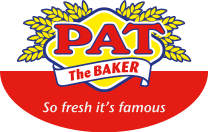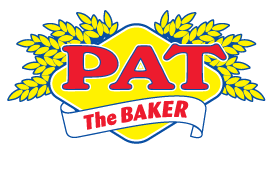Here at Pat The Baker, we cant stress The Importance of Bread. It is our policy to make Ireland’s Best Bread and to achieve this, we source the finest Quality Ingredients to make the best Quality Product on a continuous basis to the Highest Quality Standards.
Bread is a staple food prepared by baking a dough of flour and water. It is popular around the world, in every household in Ireland and is one of the world’s oldest foods.
The virtually infinite combinations of different flours and differing proportions of ingredients, has resulted in the wide variety of types, shapes, sizes, and textures available around the world. It may be leavened (aerated) by a number of different processes ranging from the use of naturally occurring microbes to high-pressure artificial aeration during preparation and baking, or may be left unleavened. A wide variety of additives may be used, from fruits and nuts to various fats, to chemical additives designed to improve flavour, texture, colour and shelf life.
Bread may be served in different forms at any meal of the day, eaten as a snack and is even used as an ingredient in other culinary preparations. As a basic food worldwide, bread has come to take on significance beyond mere nutrition, evolving into a fixture in religious rituals, secular cultural life and language.
Our bread provides energy for daily living. One slice of Pat’s Pan provides around 100 kcal which is five per cent of your recommended intake or RI (Reference Intake) for a day which is 2000 kCal.
Did you know that bread is the third biggest contributor of protein in our daily diet? Protein is essential for growth, development and repair of the body. At Pat The Baker we source wheat with high protein content to provide a high protein content bread.
Our breads are naturally low in fat and form part of a healthy, balanced diet. It’s what you add to your slice of bread that needs to be watched.
Breads are rich in complex carbohydrates. Carbohydrates are an important part of our diet as they provide us with energy.
Our bread contains various B vitamins, including Thiamin (Vitamin B1) and Niacin (Vitamin B3) which are essential for releasing energy from food.
Iron is a key nutrient in wheat flour and is essential for red blood cell formation, which aids oxygen transport around the body and is important for brain function.
Calcium is well known for its importance in the formation of good teeth and strong bones and is also important for the proper functioning of nerves, muscles, kidneys and the heart. Calcium is particularly important during teen and young adult years as this is the time when our body’s build peak bone mass. Pat’s Pan flour is fortified with calcium in the form of calcium carbonate and contributes towards healthy development of young people and maintaining a healthy diet throughout life.
Cultural Significance of Bread through the Ages
Bread has been an important staple food product to many cultures over the centuries. It is referred to as the “staff of life” in the Bible. Humans have eaten some form of bread since the Neolithic era, when cereals were crushed and mixed with water to form a thick paste that could be cooked over the fire. Stone mechanisms were used for smashing and grinding various cereals to remove the inedible outer husks and to make the resulting grain into palatable and versatile food.
Bread making techniques date back as far as 3000BC. The ancient Egyptians were experimenting with different types of grains to produce a variety of bread products with different textures and flavours. This early bread was particularly successful when wild yeast from the air combined with flour and water, starting a fermentation process and slightly rising the crust. Successful bread making was considered an important life skill for ancient Egyptians. Paintings in the pyramids show that the dead were buried with loaves of bread to provide sustenance in the afterlife.
The Romans were the first to perfect Rotary Milling. They used sieves to produce finer flour. They invented two types of oven; The “Brick” oven and the “Three legged pot”. They also introduced the world to the cottage loaf.
The Vikings made bread mainly from rye grain, which produces a dense hard bread. The Vikings brought rye from Scandinavia and produced hard primitive looking flat bread, which had large holes in the middle. To the Normans, bread making was very much an organised community activity. Crop rotation practices were in place. They constructed watermills and windmills close to the fields to facilitate flour production.
In 1266, the first bread control agency – the “Assize of Bread” – was set up to govern the weight and the price of bread. Guilds facilitated in the development of professional respect for the trade. They also helped to promote bread to the public. The bakers’ guilds in England were held to strict standards, with harsh punishments for overcharging or rendering the bread poor by adding other substances.
The development and use of roller flour mills in the 1700’s, led to the production of much better quality flours. The resulting flours, produced breads, which were lighter and whiter. The 18th century, also saw, the birth of the loaf tin and resulting loaf shaped bread, which enabled it to be easily sliced.
The industrial revolution was the next great milestone in the history of bread making. Steam powered mills were constructed to meet the demands of a growing population in Europe.
By the end of the 19th century, the steel roller mills had arrived. These mills produced much softer finer flour, which produced better quality breads. Gas ovens replaced wooden and coal burning brick ovens.
By the 20th century, highly automated flour mills with steel rollers were in place. This highly automated process resulted in the production of better quality and different varieties of flours. The efficiency of mills also increased dramatically.
Modern day bread can be leavened (aerated) by a number of different processes, ranging from the use of naturally occurring microbes, to high-pressure artificial aeration during preparation and/or baking, or may be left unleavened.
Methods of Making Bread
There are two main methods of bread making used in bakeries today:
- The Bulk Fermentation Process (BFP)
- The Chorleywood Bread Process (CPB)
The Bulk Fermentation Process
This is a traditional method. Ingredients are mixed together to form a dough and left to ferment from one up to three hours. During fermentation the dough changes from a short dense mass into elastic dough. Using different quantities of yeast and dough temperatures usually controls fermentation time. Smaller craft bakeries favour this method.
The Chorleywood Bread Process
The Flour Milling and Baking Research Association of Chorleywood in the UK developed this method in 1961. It is the most widely used method of bread making in bakeries today. It eliminates the time involved for fermentation in the traditional method.
Dough development is achieved by high speed mixing and intense mechanical working of the dough in a few minutes. To achieve this, a flour treatment agent (Ascorbic Acid) and a little fat or emulsifier need to be added, usually in the form of a bread improver. Other than mixing and bulk fermentation, all other parts of the bread making process – dough dividing, proving, baking, cooling and slicing – are the same as any other way of making bread.
There are also other methods of bread making which include:
- Activated Dough Development (ADD)
- Straight Dough Method
- Delayed Salt Method
- Sponge and Dough Process (S&D)
- Ferment Dough Process









